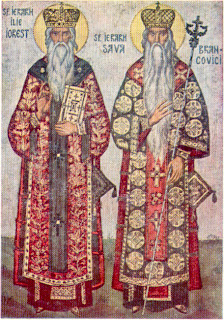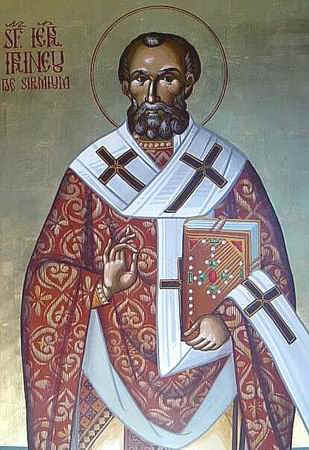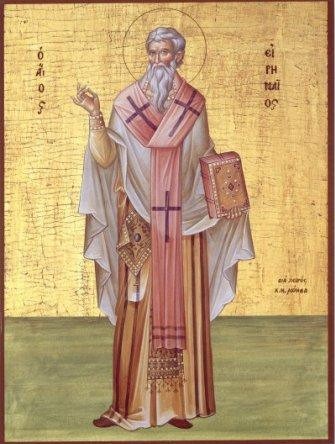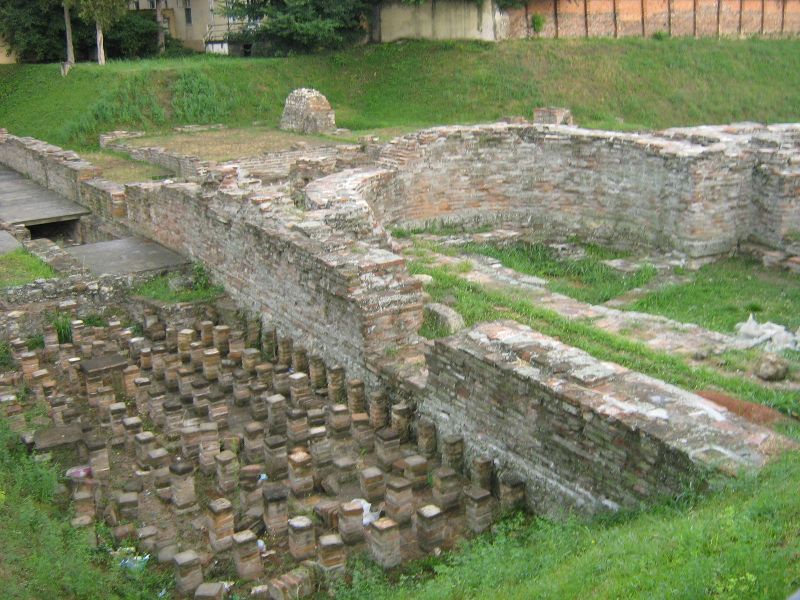The four hierarchs of Transylvania celebrated on 24 April, Ilie Iorest, Simion Ştefan, Sava Brancovici and Joseph of Maramureş were bishops over an oppressed population. The Orthodox faith and the Romanians in Transylvania had no rights in the country dominated since the middle Ages by the Hungarian noblemen, who shared the rights with the Germanic minorities. The so-called Transylvanian tolerance during the middle Ages is only half true. If the political rights of the Hungarians, Szekelys and Saxons were well respected, the Romanians had no political rights and no possibility to send representatives in the local parliament and no specific diocesan seat. Moreover, their religion was only mutually tolerated, but had no rights like the other 4 official religions (“religiae receptae”). In these conditions, the princes and the noblemen tried to convert forcibly, or by promising some rights, the Romanian population. The bishops celebrated on April 24 tried to preserve the minimal tolerance, asking for political sustaining in Moldova, Wallachia or Russia, and sometimes using compromise solutions.

Saint Ilie Iorest (1640-1643)
Saint Ilie Iorest resided as Metropolitan of Transylvania in Alba Iulia, the capital of the country at that time. There are not so many documents who attest him, but they are enough to create a portrayal of his. A letter of the Moldavian bishops addressed in 2 June 1645 to the Tsar Mikail Feodorovich of Russia attests that “this hierarch named Iorest is born in the Hungarian Country (=Translylvania), but he was instructed from his childhood in our country, Moldova, in Putna monastery, and he was tonsured as monk in the same monastery, and after a while he was ordained as priest”. His ordination may have been made by Metropolitan Anastasie Crimca of Suceava (~1607-1629), or by the retired bishop Efrem of Rădăuţi, who lived at Moldoviţa, just over the hill from Putna, or by the next bishop of Rădăuţi. The last page of a Slavonic Psalter Book from Putna comprises his not so often name, “hieromonk Iorest, vlet (=in the year) 7133 (=1625), November 8”. This notice made the historians to suppose he was born around 1600.
A decade later, in 1637 the priest Manoil from Suceava was finishing a Slavonic copy of the Byzantine Synaxarion of Simeon Metaphrastes (10th century) begun in the copyists school of Anastasie Crimca and continued by „hieromonk Iorest, hegumen”. This manuscript, kept today in St. Petersburg attests that Iorest was Abbot of Putna, one of the biggest monasteries in Moldova, in 1637.

At 3 September 1640 Gennadius
III, metropolitan of Transylvania, died and just the second day, the
superintendent of the Calvinistic confession, Stephan Katona Geleji recommended
to prince George Rakoczy I some conditions for electing a successor. Among the three candidates was a Wallachian,
the Abbot of Govora Monastery in Wallachia, a local, the dean of the priests in
Haţeg, and Iorest, recommended by Vasile Lupu, voivod of Moldova. Rakoczy
accepted the latter in October 1640 and was ordained as traditionally in the
Cathedral from Târgovişte, the capital of Wallachia, being a sufragan of the
Wallachian metropolitanate. Going in Transylvania, he reprinted the “Gospel
with teaching” from 1581 and made a lot of canonical visits, but in February
1643 he was cast away from his position, because he didn’t accept the
calvinization and the spread of a Calvinistic Catechism printed in 1642 and
also because of the worsened relations between Rakoczy and Vasile Lupu . The
letter of the Moldavian bishops to the Russian tsar attest that he was twice
imprisoned together with some other priests because he refused to convert to
Calvinism. According to the medieval Document Approbatae Constitutiones, the
religious oppression was forbidden, but the bishop was instead accused of
immoral acts. He was unjustly judged (10 October 1643) and after his releasing
by having 24 warrants who promised to pay a tax of 1000 talers, in November
1643 he fled in Moldova.
In June 1645 Iorest
left to Russia in order to collect money and other helping for the
Transylvanian clergy and for his warrants, together with German, a monk from
Putna and his nephew, Jurca. At 25 August was in Moscow and obtained an
audience to the tsar and a financial help, but no more. He remained for some
months there and later came back in Moldova, where he remained as simple monk
at Putna, until 1656 when he was for a while bishop in Huşi, but shorter afer
(1657) he came back to his monastery by unknown reasons and remained here until
his death. A menologion of January attests that “Bishop Iorist died in 7186 (=
1678), March 12” being buried outside the big church of Putna, on the eastern
side.
 |
| The tomb of St. Ilie Iorest |
Saint Simion Ştefan of Transylvania (1643-1656)
The successor of
Iorest in Alba Iulia eas Simion Ştefan, a former student at the school from the
Orthodox Monastery in Alba Iulia and later hieromonk in the same convent. He
signs with the title “Archbishop and Metropolitan of the throne of Bălgrad
(Alba Iulia), Vad, Maramureş and the whole Transylvania”. The calvinization
continued even stronger during his pastorship. Even from the election, it was
granted to him the jurisdiction of only 3 deaneries of the all 20. It may be
strange, but the canonical and pastoral jurisdiction for the rest of Romanians
was granted to the Calvinist superintendent Geleji Katona Istvan. Even from his
enthronement he was forced to sign 15 obligations, supposed to be given before
to Iorest. Among them, he was forced to preach exclusively in Romanian (because
the tradition was to preach in Slavonic). Through this apparently positive
obligation the calvinization might have been implemented easier. Also the
theological instruction should be made according to the Calvinistic catechism;
the Holy Sacraments were reduced to bread and wine as the symbol of the Body
and Blood Christi, and the cult for icons and for the Cross should have been
banished. Anyway the difference among theory and practice was big, so even he
signed the conditions, he didn’t implement them.
 |
| Depiction of the Saint in the Orthodox Cathedral from Alba Iulia |
During the pastorship
of Simion Ştefan there were printed for the first time in Romanian the New
Testament (1648) and the Psalms (1651), the most used biblical books. The
preface of the text is signed by the Metropolitan, being dedicated to Prince
Rakoczy. In this text he praised the prince because of the amount of money
given for the education of some students but also warned him that he should
care for the people under his jurisdiction should have spiritual food and
drink. Moreover, he wrote that God didn’t make the people for the kings, but
the kings for the people, in order to judge and protect them. Supposedly he is
also the author of the “Word for the readers” included in the two books. On the margins on the pages it was printed a
“Lexicon” explaining the rare words, regionalisms and neologisms. These Works
were very important because it started the process of the unification of the
Romanian language, which was not standardized before. The Metropolitan defined the
circulation of the words like this: “We know very well that the words should be
like the money, because that money is good who circulate in all the countries.
The same thing is with the words, these are good, which are understood by all”.
He knew the limitations of his work so that he brought in attention the
difficulties of translation and using the best words, in order to be understood
by all. That is why he reproduced in this preface a formula of humility
presented already in another Orthodox books as Pravila (The Law) of Govora
(1640): “Consider, ye reader in this book, because it was not written by the
angels from heaven, but from a sinful hand, made from dust”. About 200 years
later, Andrei Şaguna, another metropolitan of Transylvania attested the
importance of the first translation of the Bible, which influenced the whole
future language.
 |
The first page of the Romanian New Testament
of Simion Ştefan |
The translations of
the biblical books were not addressed only to the Orthodox in Transylvania but
also to the others, so he contributed to the both spiritual and cultural
edification of the Romanians. Simion Ştefan might have died in 1656 when his
successor is attested. His burial place is unknown.
 |
Alba Iulia during the canonization of Simion Ştefan
|
St. Sava Brancovici (1656-1683)
The life of Sava
Brancovici is well known, being described in a Serbian chronicle written by his
brother, George. He was from Serbian ancestry from Korenic, in Hertzegovina. At
the end of the 16
th century his family fled in Arad because of the
Ottoman expansion. Sava was born and baptized as Simeon in 1620 learning in
Hungary, Serbia and Bulgaria. Later he went to Comana Monastery, southern from
Bucharest, where his uncle Longin was Abbot and bishop. Later he came back home
due his father’s death and later married and had children, but all died young.
Simeon was ordained priest by Metropolitan Ştefan of Wallachia and on the way
back home he heard about the death of his wife. He remained as priest and dean
in Ineu (near Arad) for some years, being in the same time the leader of the
Romanians in front of the Turkish expansion.

In the summer of 1656
Simion Ştefan died and the Orthodox council in Alba Iulia elected him as
Metropolitan. Consequently he was tonsured as monk in Wallachia, receiving the
name of Sava at the Feast of the Holy Cross (September 14). On September 16 he
was ordained bishop and went back to Transylvania. He had had the same problems as his
predecessors and even more. Transylvania was at the time ruled by two parties,
a pro-Ottoman and a pro-Austrian one. The changes at the throne happened during
1657-1662 made possible the official recognition of Sava only by the
pro-Ottoman prince Michael Apaffy, at 23 April 1662. As Ilie Iorest, Sava
started in 1668 a long journey to Moscow, in order to find political and
financial help for the Romanians in Transylvania. In audience to the tsar
Aleksey Mikhailovitch Romanov he presented a memory about the harsh conditions
of the Romanians, Serbs and Bulgarians under the Turkish rules. After the
second audience, on 2 August 1668 he became a financial help and the promise
that the Tsar will help his diocese in the next seven years. At Christmas he
was back in Alba-Iulia.
The Russian journey
made him problems and the pro-ottoman prince found out that Sava asked for
political help too. So he imposed to the hierarch some restrictions. The
metropolitan was from February 1669 on subordinated to the Calvinistic bishop
and could not ordinate priests, judge, make canonical visits and call the Synod
without the acceptance of the superintendent Peter Kovasznai.
 |
| George Brankovic, the brother of the Saint |
In 1670 Sava went to
Wallachia and obtained from the voivod Antonie of Popeşti an annual allocation
of 6000 of Aspers (late byzantine silver coins named in the Ottoman period as
akçe). Back in Transylvania, Sava was present at the consecration of Moisei
monastery in north and of the church in Vlădeni, in south.
In 1675 Sava called a
synod at Alba Iulia and decided the Romanization of the liturgical service,
held until then in Old Slavonic. Also they decided the holding of the
ceremonies also outer from the churches, in case of necessity. Other decisions
were: dispositions for the priests for the catechization of the children,
disciplinary norms, especially against the superstitions in the cult of the
dead, quite spread among the Romanians. Finally, there were also norms about
the learning of the basic prayers, about the Holy Communion at least during the
4 Lents during the year. These measures conducted to a special relation with
prince Apaffy who granted some administrative facilities. In any case, the favorable situation ended in
1680 when the new Calvinist superintendent, Michael Mihail Tóföi discovered a
complot against the prince, among whom was involved Gheorghe Brancovici, the
brother of the metropolitan. The prince called a judgment council in Sibiu,
composed of 101 priests and laymen who accused the metropolitan of immorality
and neglecting the monastery and the typography in Alba Iulia. It was partly
so; it is said he might have hidden the typography, because in it there were
printed Calvinistic books, so he wanted to prevent the spreading the books of
other confession among the Orthodox. He was dismissed according to the 81th and
82
nd canon of the Calvinist Church and 75
th canon of the
Romanian law and his properties, including books and the typography were
confiscated. The Metropolitan and his brother were imprisoned in the prince’s
castle from Blaj. Later his brother was sent in Wallachia in order to redeem
both of them for 3000 talers. Sava was beaten regularly in the yard of the
castle on Fridays (Chronicler Cserei Mihaly) and once he was so strong beaten
with whips until the flesh was torn from him (according to the German
chronicler Andreas Gunesch). Gheorghe asked for help from Şerban Cantacuzino,
the prince of Wallachia and Apaffy consented for the freedom of the metropolitan.
At the beginning of 1683 Emperor Leopold I of Austria granted him the title of
baron, but he died shortly after his release, because of the harsh conditions in
prison, in April of the same year. His burial place is also unknown.

St. Martyr Iosif (Joseph), bishop of Maramureş
(1690-1711)
Northern Transylvania,
also known as Maramureş (or Marmaroshchina in Ruthenian) had its own bishops in
Munkach (Mukacevo in Ukraine). In 1646 a part of the priests and believers
accepted the conditions of the Union of Brest (1656) and became Greek-catholic.
But a part of them wanted to preserve their confession, and elected a new
bishop for the remained Orthodox believers, in the person of the widower priest
Iosif Stoica, nobleman from Criciova (today in Ukraine). He was tonsured as
monk and later ordained as bishop by Dosoftei, the exiled metropolitan of
Moldova, in Jolkiew, Poland. The residence of Bishop Joseph is unknown. He
signed in 1692 on an Antimension with the name “Joseph, from God’s mercy
orthodox bishop of Maramureş, stauropegial Constantinople exarch and locum tenens
of the Metropolinate of Transylvania from Bălgrad (Alba Iulia)”. The Hungarian
historian Nicolae Bethlen, former chancellor of Transylvania during that
period, has noted that Iosif Stoica wrote a letter opposing union with the
Roman Church, based on arguments from the Scriptures and the writings of the
Church fathers. Bethlen noted his surprise that a rural Romanian was able to
produce "a letter of such theological strength".
His relatively
peaceful pastorship was struggled in 1701 when he was called in Viena and it
was proposed to him to renounce to the Orthodoxy in change of some material
advantages, but he refused. In 1705 the
vice-count of Maramureş, Franciscus Darvay obliged Joseph to sign a programme
in 20 paragraphs which were against the Orthodox faith. He refused and so was
arrested and imprisoned in Chust. His
priests protested, but without any result. During this detention, in 1707 they
have elected a new bishop in the person of Iov (Job) Ţârca who was also
persecuted, but fled in Moldova so he was convicted to death in the absence. After
being released in 1711, Joseph Stoica continued to exercise his episcopal
functions without the knowledge of the authorities. He tried to recover his
bishopric officially, but died in the same year. He is supposed to be buried in the old church
situated on the Crosses’ Hill in the village Mânăstirea (=the monastery),
Giuleşti commune near Baia Mare, the today capital of the county. Joseph
remained in the memory of the Orthodox believers in Maramureş as a protector of
their faith against the rulers.
 |
The probable burial place of St. Joseph
in Giuleşti monastery of the St. Archangels |
The veneration of the Transylvanian hierarchs
Ilie Iorest and Sava
Brancovici were proposed for canonization in 1950 by Nicolae Bălan,
metropolitan of Transylvania at that time. His proposition was made in account
of the pure life and for their devotement in preserving the faith against the
oppressive system. The Romanian Synod approved the canonization of them in 25
February 1950 and decided the two to be jointly celebrated on April 24, the
date of death of St. Ilie Iorest, as confessor saints. The solemn canonization was
held in the Orthodox cathedral in Alba Iulia, in 21 October 1955 and
subsequently their service was introduced into the liturgical books. The other
two canonizations are recent: about of the St. Joseph it was decided by the
Romanian Synod on 20 June 1992, and the one of Simion Ştefan on 21 July 2011
for the same reasons, the purity of lives and the stability in fait. They are celebrated
since then on 24 April too, jointly with the two other metropolitans.
 |
| The Canonization of St. Simion Stefan in Alba Iulia |
Troparion (hymn) of the Holy Hierarchs Iorest
and Sava:
“Confessors of
Orthodoxy and good hierarchs of the Church of Christ, teachers the people,
blessed Hierarchs, victory carriers Iorest and Sava, you who were honored with
the crown of life, pray God to save our souls!”
Troparion
(hymn) of the Holy Hierarch Joseph:
“Great servant of God,
Holy Father Hierarch Joseph, we honor in songs and remember your name. For
confessing Christ in Maramures and defending the Orthodoxy, you protected your
flock. For this, pray to Christ God to save our souls!”
Troparion (hymn) of St. Simion Ştefan
"Loving the
beautiful Paradise of the Scriptures, Holy Simeon Ştefan, you have expounded
the New Testament in the Romanian language. Your zeal and love for your sheep
was great and the troubles from the enemies of the Orthodoxy were also great.
Pray to Christ our God to grant us unity in faith and great mercy!”

















.jpg)



























